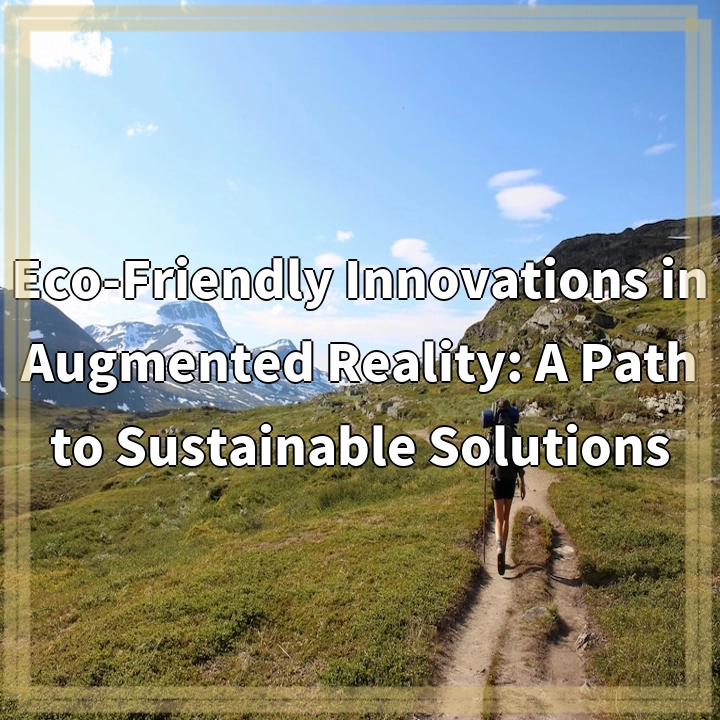
What is Eco-Friendly Innovations in Augmented Reality?
Augmented reality (AR) is a technology that overlays digital information or computer-generated content onto the real world, enhancing users’ perception and interaction with their surroundings. Eco-friendly innovations in augmented reality refers to the development and utilization of AR applications, devices, and solutions that have a positive impact on environmental sustainability.
Real-World Problems
1. Energy Consumption
One of the key challenges associated with augmented reality is its energy consumption. AR applications typically require high processing power, which in turn demands significant energy resources. This, in turn, contributes to the carbon footprint and increases the overall energy consumption. To address this problem, eco-friendly AR innovations aim to optimize energy use by developing energy-efficient hardware, software, and algorithms.
2. E-Waste Generation
The rapid growth of the augmented reality industry leads to a rise in electronic waste (e-waste) generation. AR devices, such as headsets and smart glasses, often contain materials that are harmful to the environment and human health. Eco-friendly innovations in AR focus on developing sustainable materials, implementing recycling programs, and encouraging responsible disposal practices to mitigate the negative impacts of e-waste.
3. Carbon Emissions
Transporting AR devices, especially for large-scale events such as conferences and exhibitions, results in carbon emissions from transportation vehicles. Additionally, the manufacturing process of AR devices and components contributes to carbon emissions. Eco-friendly AR innovations aim to reduce carbon emissions by emphasizing locally sourced materials, sustainable manufacturing processes, and promoting virtual meetings and conferences as alternatives to physical presence.
4. Natural Resource Depletion
Augmented reality relies on various natural resources, such as rare earth elements, minerals, and metals, for the production of devices and components. The extraction and mining of these resources often have negative environmental and social impacts. Eco-friendly innovations in AR strive to minimize resource consumption by utilizing recycled materials, exploring sustainable alternatives, and promoting circular economy principles.
5. Lack of Awareness and Education
Many individuals and organizations are not aware of the environmental issues associated with augmented reality or the potential for eco-friendly innovations within the field. Addressing this problem requires raising awareness and providing education on sustainable AR practices and solutions. Promoting the benefits of eco-friendly AR innovations can encourage both developers and end-users to adopt more sustainable approaches.
Eco-friendly innovations in augmented reality pave the way towards sustainable solutions by addressing these real-world problems. By considering the environmental impact throughout the lifecycle of AR technologies, we can harness the potential of AR while minimizing its negative consequences and creating a more sustainable future.

Summary: Solutions for Eco-Friendly Innovations in Augmented Reality
Solving the real-world problems associated with eco-friendly innovations in augmented reality requires proactive measures and sustainable solutions. Here are some key approaches:
1. Energy Efficiency Optimization
Developing energy-efficient hardware, software, and algorithms for AR applications can significantly reduce energy consumption and minimize the carbon footprint. By prioritizing energy efficiency, we can create AR experiences that are environmentally sustainable.
2. Responsible E-Waste Management
Implementing recycling programs, encouraging responsible disposal practices, and exploring sustainable materials for AR devices can help minimize e-waste generation and its negative impacts on the environment and human health.
3. Carbon Footprint Reduction
Minimizing carbon emissions associated with AR devices can be achieved through local sourcing of materials, sustainable manufacturing practices, and promoting virtual meetings and conferences as alternatives to physical presence.
4. Resource Conservation
By utilizing recycled materials, exploring sustainable alternatives, and embracing circular economy principles, we can reduce the reliance on scarce resources, minimize extraction and mining impacts, and promote responsible resource consumption.
5. Awareness and Education
Raising awareness about the environmental issues associated with augmented reality and promoting the benefits of eco-friendly AR innovations can encourage individuals and organizations to adopt more sustainable practices. Education plays a crucial role in inspiring sustainable actions within the AR industry.
By implementing these solutions, we can harness the potentials of augmented reality while safeguarding the environment for future generations. Eco-friendly innovations pave the way towards a sustainable future, where augmented reality can coexist with responsible environmental stewardship.















